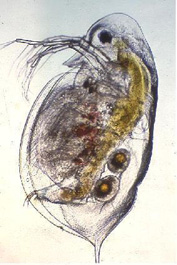
|
|

The FLAMES Lab The Field Laboratory for the Assessment of Multiple Ecological Stressors |
|
Plankton assemblages in Canadian Shield lakes are currently in a state of dramatic flux, but we cannot explain these changes by simply looking at environmental co-variations, eg. changes in lake physics, chemistry or fisheries assemblages that may be correlated with zooplankton changes. The problem is not simply that correlation may not connote causation, rather it is that there are so many significant correlations. To identify the cause or causes of these changes I have constructed the FLAMES lab at Dorset, in collaboration with the Ontario Ministry of the Environment. With the facilities of this lab we can determine which among the logical possibilities are the actual explanations for ecological change on the Shield. In the FLAMES lab we maintain many cultures of zooplankton isolated from central Ontario lakes, and they are maintained in fully-defined media modeled after the chemistry of Dorset-area lakes that support diverse plankton assemblages. The lab is designed to allow us to test (in batch or continuous flow mode) the separate and joint effects of multiple ecological stressors on zooplankton in soft-water across a range of temperatures. Dallas Linley, the FLAMES lab supervisor, maintains the lab in a state of readiness for the use of multiple students and researchers. All our media are prepared from scratch starting with extremely pure chemical-free water. The experiments are normally conducted across a range of temperatures, as climate change is a reality in the area. There is lots of room for students and collaborating scientists to work, as the foot print of the lab is a roomy 2700 square feet. Here are some examples of recent or ongoing work being conducted in the FLAMES lab: 1. Dawn Ashforth (MSc 2006 York University) determined how Ca thresholds affecting population parameters of Daphnia pulex would be affected by changes in temperature and food availability. 2. Dallas Linley (FLAMES lab supervisor) identified Ca thresholds affecting population parameters of 4 daphniid species in softwater. 3. Dr. Howard Riessen (SUNY Collge Buffalo) is identifying the fitness tradeoffs of size at maturity, and production of neck teeth of differently sized daphniid species in response to different sized invertebrate predators. 4. Martha Celis-Salgado (PhD student, York University) is quantifying the affects of Cu and Ni, alone and in mixtures, on Daphnia species at various temperatures and Ca levels in order to explain the delayed recovery of Cladocera in comparison with Copepoda in Sudbury lake. 5. Natalie Kim (MSc student, York University) is quantifying the effects of light, temperature and pH on probability of establishment success of the spiny water flea, Bythotrephes. 6. Christine Gibson (incoming MSc student, York Unviversity) will be looking at the effects of pH and temperature on Ca thresholds of various species of daphniids in soft-water media.
|
Copyright © 2007 Nicom Digital® | Website by Konrad Paliga